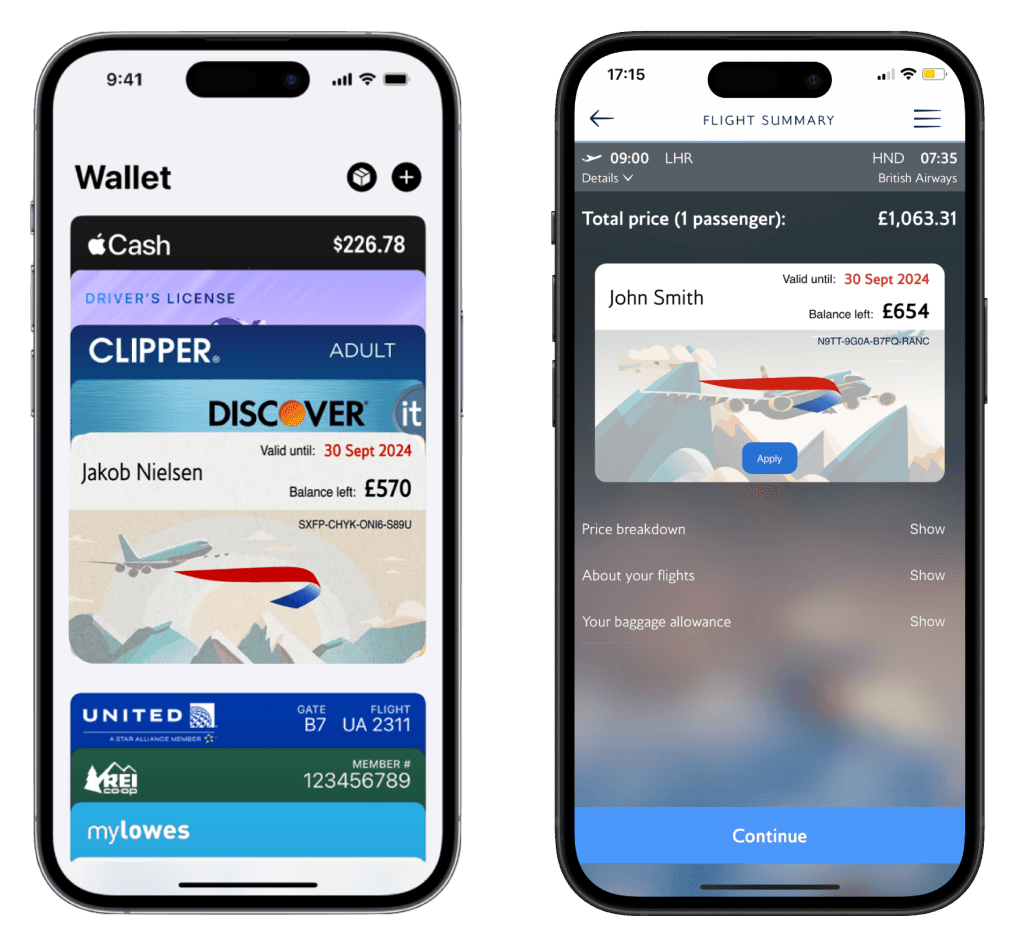
24h Hackathon (British Airways x BrainStation)
Encouraging customers to book flights using their travel eVouchers
My Role
UX Research
UX & UI Design
Project Timeline
24 Hours
Tools
Figma, Photoshop, Illustrator
Project Overview
Background Context
British Airways is a global airline, bringing people, places and diverse cultures closer together for more than 100 years. British Airways customers whose flights or holidays were delayed or cancelled in 2020-21 could exchange their payment for a voucher to use at a later time. Since 2020, many travel vouchers issues have gone unused.
The Problem
Large number of unused vouchers that were issued in 2020-2021. The company intends to reduce the amount of unused vouchers by encouraging customers to use them. This would cover all flights globally and customers will not be able to redeem vouchers for BA holidays. The key outlines involves encouraging customers to purchase new flights to travel anywhere around the world, using the existing vouchers under their name.
The Solutions
By converting the e-vouchers to e-cards, it provides a smoother experience for users to apply them when purchasing their flights whilst also creating a novelty connection with the card as it is fully customisable to their liking and linked to their British Airways accounts.

The Challenge
British Airways is looking for opportunities to encourage their customers to use their travel vouchers before they expire, as many are still left unused years later.
Our Approach
Due to the strict time restriction, the team first listed specific constraints that would outline our project. By knowing the team’s capabilities and limits at producing certain deliverables, we have a realistic understanding of what we can achieve in the allotted timeframe.
1
Our Software Engineers highlighted that they could only realistically create a website within the 24-hour timeframe, so they can concentrate on the prototype deliverable.
2
Our Data Scientists informed us that due to limited access to British Airways’ public datasets, we had to obtain our data and findings through secondary means such as older datasets and other comparable scaled airlines for reference.
Our Goal
Increase the number of customers using their soon-to-be expired e-vouchers. To do this, we looked at new ways to ensure e-vouchers are more readily applicable for payment options
Research Insights
Our team of Data Scientists alongside the Product Designers collaborated to find relevant findings related to customers’ experience purchasing flights and using e-vouchers. From this we could make high-level assumptions of our target users.
We identified British Airways’ website as our main focus of interest as most people prefer purchasing flights via desktop.
We also highlighted the age groups of our target users to be 25-35 years old, with the tendency to solo travel for shorter 1-2 weeks span.
Key Competitors’ Analysis
Before coming with possible solutions, we decided to look at two competitors’ websites and identify how they handle customer e-vouchers. From evaluating both sites, we discovered some key areas to consider.
We decided on Icelandic Air and Emirates as they were not sister companies or affiliated with British Airways. They both also serve internationally at various scales, making them good case study references.

Hover over the images to see how these companies have implemented their e-vouchers section!
Icelandic Air

Emirates

1
The option to use e-vouchers is clearly visible for the users and is easy to understand.
2
The instructions are easy to follow and distraction-free from other actions.
3
The webpage is simplified for the users to ensure there is no cognitive overload.
1
The e-voucher section was quite difficult to locate when scrolling quickly through the process.
2
The instructions to apply the e-voucher is more detailed. However, this may confuse the users as the layout is not as cohesive and jumbled.
3
There is an extra step to applying the voucher compared to Icelandic Air, making it more difficult to use.
Key Target Users
Using our insights, we created a proto persona that our solution is geared towards.
How Might We...
encourage younger travellers (aged 25–35) like Dustin, to book flights for their weekend trips using their travel e-voucher?
Analysing Existing Website
We analysed the existing website and mapped out the user journey for customers who wanted to book a flight. Through this, we identified key areas where we could intervene to implement a solution. The existing user flow can be broken down into 4 main sections as shown below.
Press each tab to see our plans of intervention!

Picking flight destination
Selecting flights
Reviewing flights
Payment & confirmation

The Solution
Our goal was to create a lasting connection between British Airways and it’s customers by streamlining the experience of e-voucher usage for their flight bookings. By doing so, customers are reminded and encouraged to use their e-vouchers before they expire.
Reminder
Customers are sent an email to link their eVoucher codes to their accounts to obtain an e-card

Personalisation
Inspired by British Airways’ Executive Club cards, customers can customise their cards for a more personal connection to the item than an easily forgettable email code.

Easy Access
Customers can pay using the card at the click of a button instead of typing a code. It is a easily visible at the checkout page for quick access.

Add to e-wallet
E-cards can be added to the e-wallet to use if purchasing flights via a mobile device.

Closing Thoughts
Key Takeaways
It was a very insightful and rewarding experience to be able to work on a brief with a real-life problem. To be able to apply everything I had learnt from the bootcamp within a 24 hour timeframe alongside the team made me realise that the project wouldn’t have been possible without tremendous teamwork. It taught me to work and communicate with other team members, and understanding how they work. Working around each disciplines constraints prove to be a challenging task, which made me aware of implementing a product that was both creative but fundamentally practical to users – it needed to be user-centric whilst ensuring viability for both clients and stakeholders.
What went well?
I really enjoyed working in collaboration with the other disciplines to see how each other’s work influences the overall project. I was extremely proud of the team’s perseverance and ambition to pitch a creative solution that tackled the users’ needs and created an interactive and personal connection with the users, which was well received by other teams and the British Airways judging panel.
What could have been better?
Due to the nature of the brief and its time constraint, we encountered difficulties prioritising certain tasks and underestimating the time taken to complete certain deliverables. Reflecting on the experience, it may have been better to delegate one leader that oversee all activity instead of three leaders (from each discipline).






